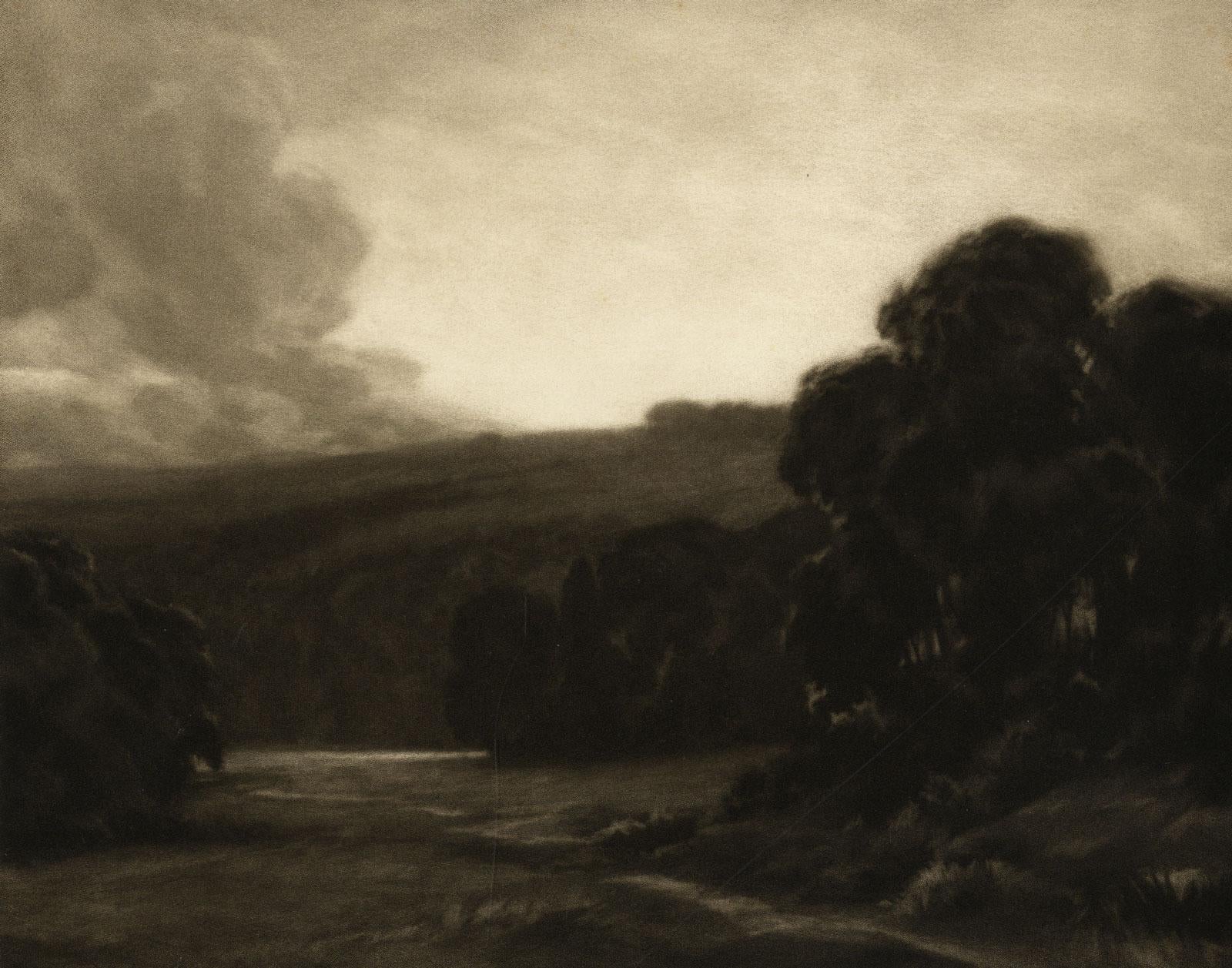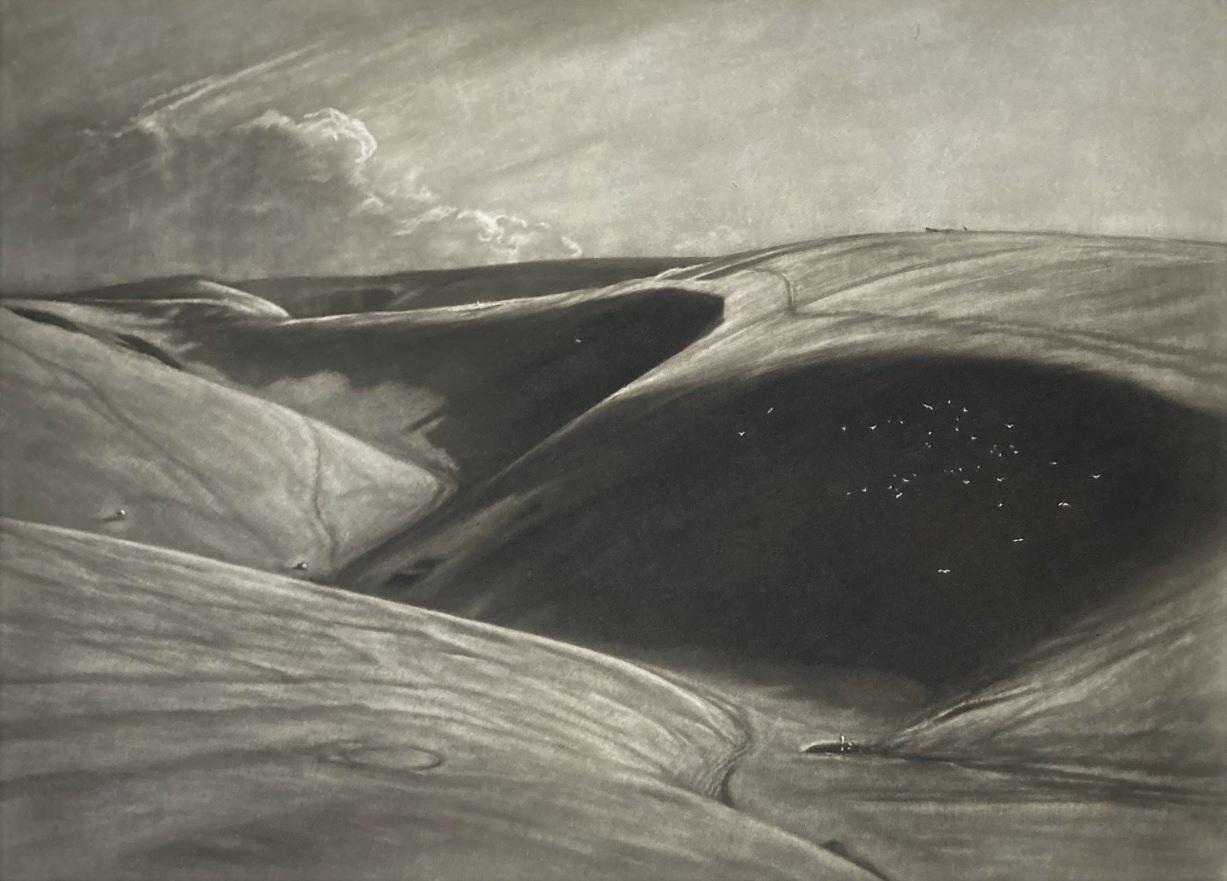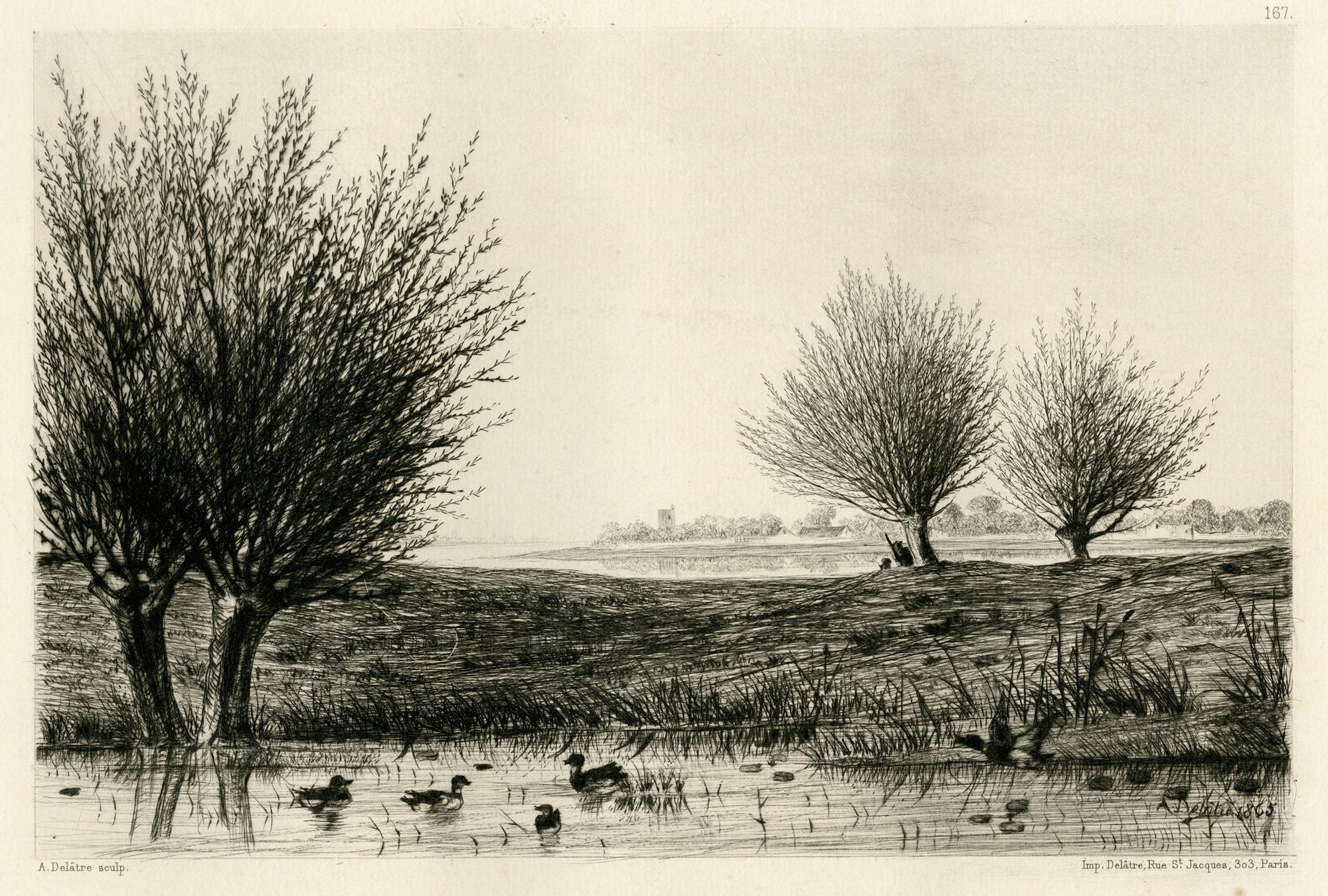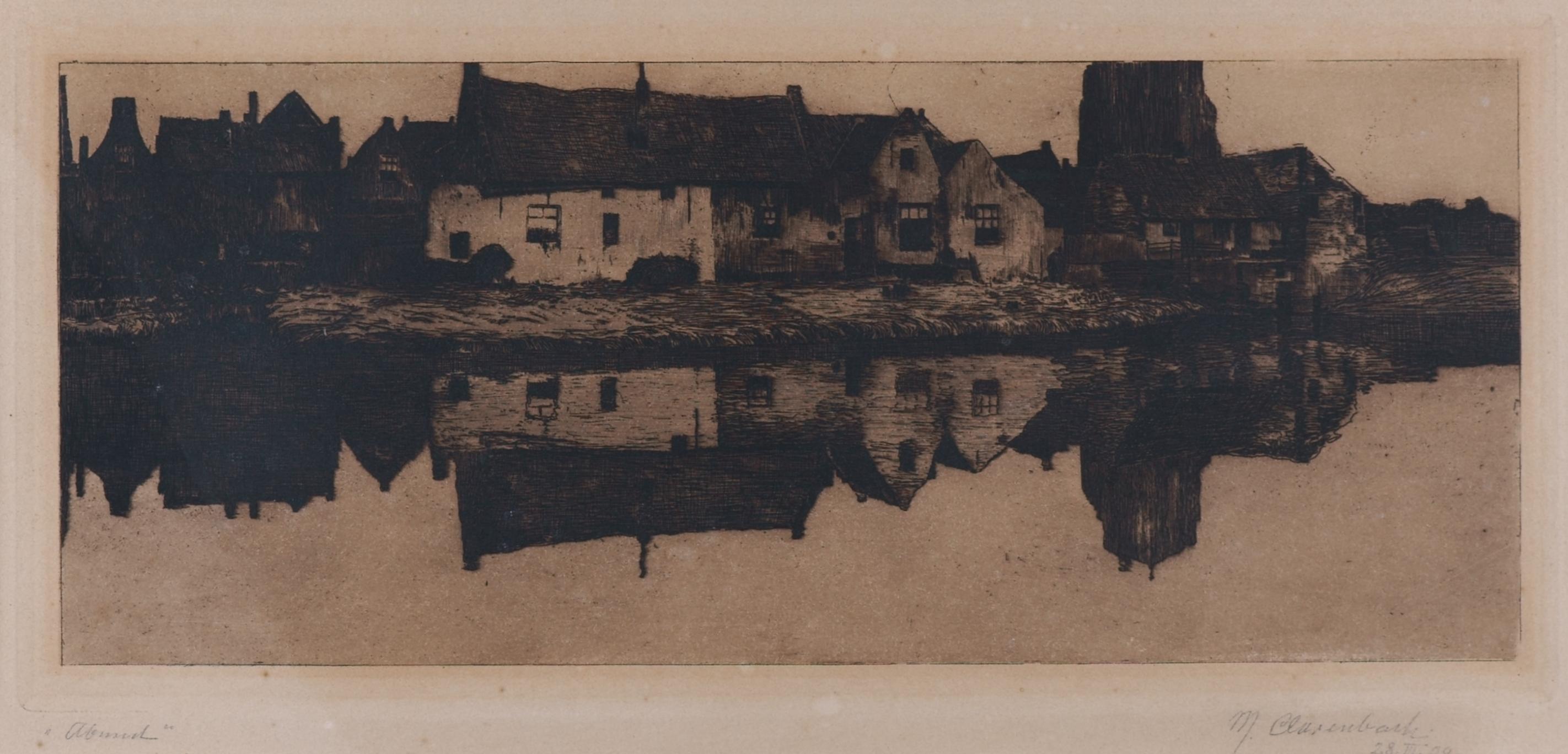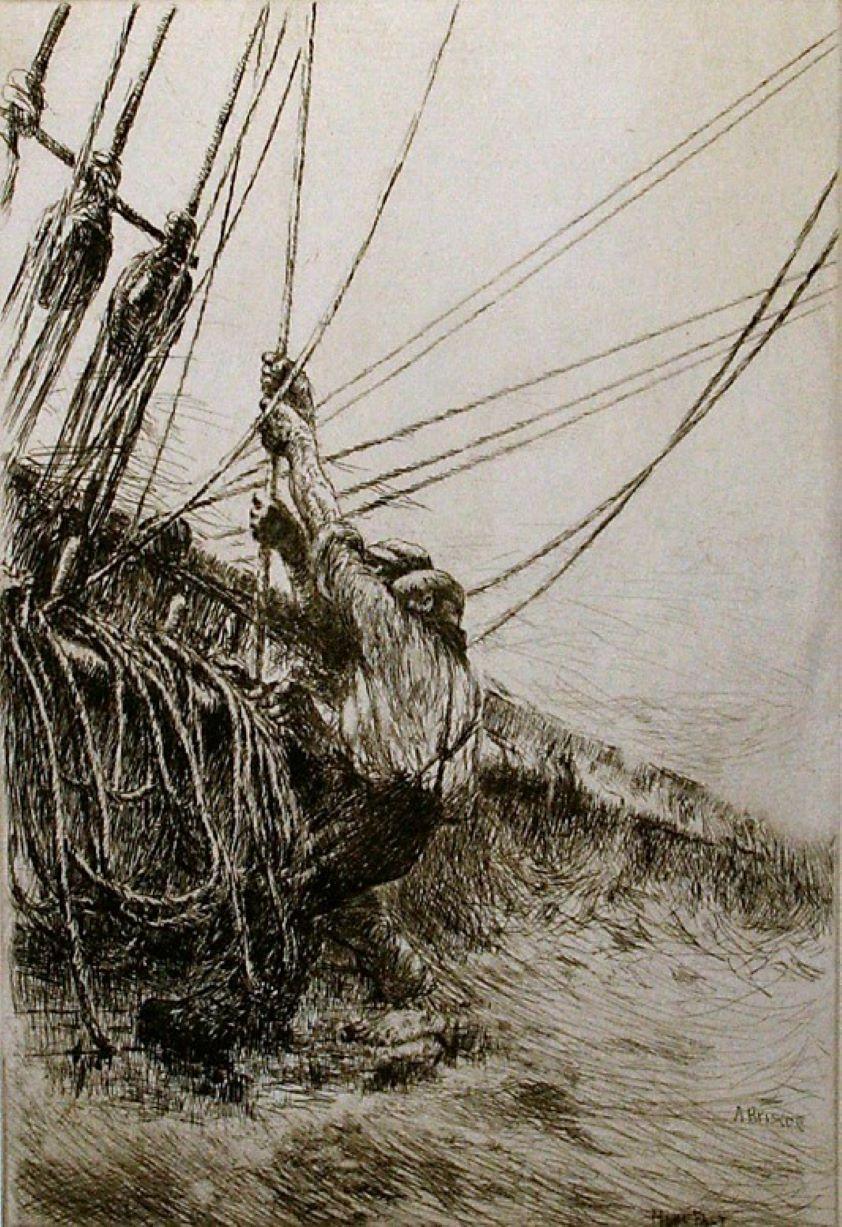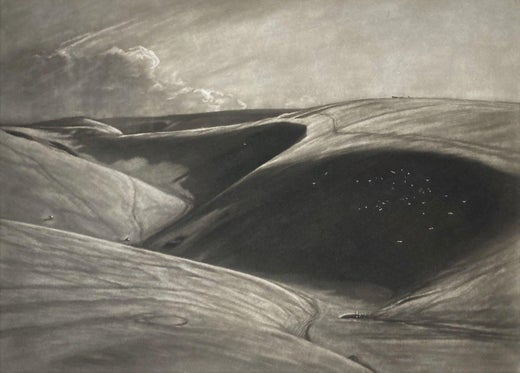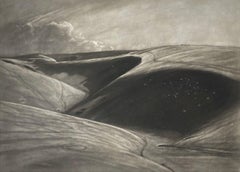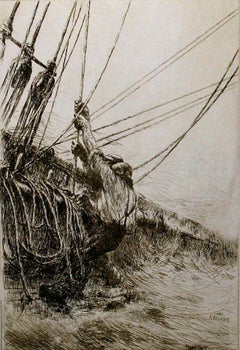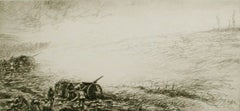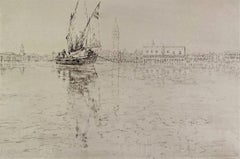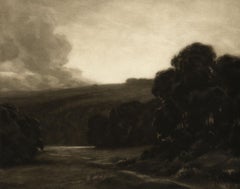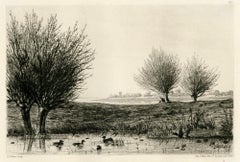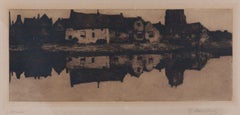Want more images or videos?
Request additional images or videos from the seller
1 of 3
Sir Frank ShortTwixt Dawn and Day1919
1919
$500
$82539% Off
£377.83
£623.4339% Off
€436.31
€719.9039% Off
CA$698.67
CA$1,152.8139% Off
A$775.24
A$1,279.1439% Off
CHF 406.09
CHF 670.0439% Off
MX$9,506.50
MX$15,685.7339% Off
NOK 5,165.28
NOK 8,522.7139% Off
SEK 4,875.80
SEK 8,045.0839% Off
DKK 3,253.80
DKK 5,368.7739% Off
Shipping
Retrieving quote...The 1stDibs Promise:
Authenticity Guarantee,
Money-Back Guarantee,
24-Hour Cancellation
About the Item
Twixt Day and Dawn. 1919. Aquatint. Hardie catalog 165 state ii. Image 9 7/8 x 11 1/2 (sheet 13 9/16 x 16 7/8). A masterly inked impression produces subtle lighting variations throughout the image. Printed on the full sheet of white wove paper with deckle edges on all sides. Signed in pencil.
The scene presents the delicate effect of the first light of dawn as the sun begins to rise. The first birds have appeared in the sky and the moon is still up. The cow/s breath sends steam in the chill morning air. The image is one of the artist's finest works in the medium of aquatint.
Sir Francis Job "Frank" Short PPRE (19 June 1857 - 22 April 1945) was a British printmaker and teacher of printmaking. He revived the practices of mezzotint and pure aquatint, while expanding the expressive power of line in drypoint etching and engraving. Short also wrote about printmaking to educate a wider public and was President of the Royal Society of Painter Etcher & Engravers (now styled the Royal Society of Painter-Printmakers) from 1910 to 1938. Short was elected to the Royal Academy in 1911, the same year he was knighted, and served as the R.A.'s Treasurer from 1919-to 1932. He was also President of the Royal Society of Painter-Etchers and Head of the Engraving School of the Royal College of Art, where he taught from 1891-to 1924.
According to his friend and colleague, Martin Hardie: ''Physically strong, with a powerful frame, a massive head, and large and benevolent eyes, Short was a man of quiet manner and kindly impulse, but of firm character and great strength of will.
- Creator:Sir Frank Short (1857 - 1945, British)
- Creation Year:1919
- Dimensions:Height: 9.88 in (25.1 cm)Width: 11.5 in (29.21 cm)Depth: 0.5 in (1.27 cm)
- Medium:
- Movement & Style:
- Period:
- Condition:
- Gallery Location:Storrs, CT
- Reference Number:1stDibs: LU335210058532
Sir Frank Short
Sir Francis Job "Frank" Short PPRE (19 June 1857 - 22 April 1945) was a British printmaker and teacher of printmaking. He revived the practices of mezzotint and pure aquatint while expanding the expressive power of line in drypoint etching and engraving. Short also wrote about printmaking to educate a wider public and was President of the Royal Society of Painter Etcher & Engravers (now styled the Royal Society of Painter-Printmakers) from 1910 to 1938. Short was elected to the Royal Academy in 1911, the same year he was knighted, and served as the R.A.'s Treasurer from 1919-1932. He was also President of the Royal Society of Painter-Etchers and Head of the Engraving School of the Royal College of Art, where he taught from 1891-1924.
About the Seller
5.0
Recognized Seller
These prestigious sellers are industry leaders and represent the highest echelon for item quality and design.
Established in 1977
1stDibs seller since 2016
725 sales on 1stDibs
Typical response time: 2 hours
Associations
International Fine Print Dealers Association
- ShippingRetrieving quote...Shipping from: Storrs, CT
- Return Policy
Authenticity Guarantee
In the unlikely event there’s an issue with an item’s authenticity, contact us within 1 year for a full refund. DetailsMoney-Back Guarantee
If your item is not as described, is damaged in transit, or does not arrive, contact us within 7 days for a full refund. Details24-Hour Cancellation
You have a 24-hour grace period in which to reconsider your purchase, with no questions asked.Vetted Professional Sellers
Our world-class sellers must adhere to strict standards for service and quality, maintaining the integrity of our listings.Price-Match Guarantee
If you find that a seller listed the same item for a lower price elsewhere, we’ll match it.Trusted Global Delivery
Our best-in-class carrier network provides specialized shipping options worldwide, including custom delivery.More From This Seller
View AllThe Shadowed Valley.
By Sir Frank Short
Located in Storrs, CT
Sir Frank Short, R.A., P.R.E. 1857-1945. The Shadowed Valley. 1927. Mezzotint. Hardie 128. 14 3/8 x 19 3/8 (sheet 19 x 24). A rich, glowing impression p...
Category
1920s Modern Landscape Prints
Materials
Mezzotint
$2,750 Sale Price
38% Off
Make Fast, Plate 2.
By Arthur John Trevor Briscoe
Located in Storrs, CT
Make Fast, plate 2. 1929. Etching. Laver catalog number 146; Hurst catalog number 258. Plate: 14 3/8 x 9 13/16 (sheet 17 5/8 x 11 3/4). Trial proof 2, before the edition or 75. Ill...
Category
1920s Modern Landscape Prints
Materials
Etching, Drypoint
$1,800 Sale Price
20% Off
Open Action.
By Kerr Eby
Located in Storrs, CT
Published edition, not trial proof
Open Action. 1926/1928. Etching. Giardina 124. 7 x 15 1/8 (sheet 12 3/4 x 15 1/4). Trial proof, prior to the edition of 90. A rich, tonal impressi...
Category
1920s American Modern Landscape Prints
Materials
Etching
$1,200 Sale Price
31% Off
A Mirage
By James McBey
Located in Storrs, CT
A Mirage. 1928. Etching. Hardie 238. 11 13/16 x 14 3/8 (sheet 12 3/16 x 18 3/4). Edition 76, #46. Illustrated: Fine Prints of the Year, 1928 and 1938; Holmes, Etchings of Today. A ri...
Category
1920s Modern Landscape Prints
Materials
Drypoint, Etching
$1,750 Sale Price
30% Off
The Deserted Palace.
By James McBey
Located in Storrs, CT
The Deserted Palace. 1928. Etching. Hardie/Carter 236. 8 1/2 x 10 (sheet 10 1/2 x 12 3/8). Edition 80, #53. A rich impression printed in bistre ink with pl...
Category
1920s Modern Landscape Prints
Materials
Etching
$1,800 Sale Price
20% Off
The Vraic Season (No 1).
By Edmund Blampied
Located in Storrs, CT
The Vraic Season (No 1). 1936. Etching. Appleby 181. 12 x 14 1/4 (sheet 15 1/4 x 20). Edition 125 for The American College Society of Print Collectors (alternatively titled Seaweed H...
Category
1930s Modern Landscape Prints
Materials
Drypoint, Etching
$900 Sale Price
40% Off
You May Also Like
Dawn
By Percival Gaskell
Located in New Orleans, LA
Mezzotint. 8 x 9 7/8 (sheet 13 7/8 x 19 3/4). A fine impression with tone printed in dark brown ink on white wove paper. Signed in pencil.
Category
1930s English School Landscape Prints
Materials
Mezzotint
Le Matin
Located in Middletown, NY
Paris: Cadart & Luquet, 1865
Etching and engraving on Chine-collé mounted to watermarked Aqua-Fortistes cream laid paper, 9 5/8 x 12 3/4 inches (243 x 322 mm), full margins with thr...
Category
Mid-19th Century French School Landscape Prints
Materials
Handmade Paper, Engraving, Etching
Sunrise
By Robert Andrew Parker
Located in Aventura, FL
Lithograph on Rives BFK paper. Hand signed and dated on front by Robert Andrew Parker. Hand numbered 147/200. Artwork size 30 x 22.25 inches.
From America: The Third Century por...
Category
1970s Contemporary Landscape Prints
Materials
Paper, Lithograph
$712 Sale Price
25% Off
Evening - The depth of the visible -
Located in Berlin, DE
Max Clarenbach (1880 Neuss - Cologne 1952), Evening. Etching, 18 x 41 cm (platemark), 33.5 x 57 cm (frame), inscribed "Abend" in pencil at lower left, signed and dated "M. Clarenbach. 28.III.[19]09". Framed and mounted under glass.
- Somewhat browned and slightly foxed.
About the artwork
The horizontally elongated etching depicts the panoramic view of a small town as seen from the other side of the river. There are gabled houses on the left and a mighty church spire on the right. The bourgeois houses and the large religious building indicate the urban character. These buildings are rendered in dark tones to emphasise the lighter row of houses in the centre of the picture, closer to the water. The chiaroscuro contrast creates two parallel planes that open up a space for the imagination of what the city could be. The imagination is stimulated by the almost entirely dark, barely recognisable buildings, while the arm of the river leading into the city further stimulates the imagination.
However, as the silhouette of the city as a whole is reflected in the water, the parallel planes are perceived as a band of houses that stretches across the entire horizontality of the etching and seems to continue beyond the borders of the picture. The reflection has almost the same intensity as the houses themselves, so that the band of buildings merges with their reflection to form the dominant formal unit of the picture. Only the parallel horizontal hatching creates the convincing impression of seeing water, demonstrating Max Clarenbach's mastery of the etching needle.
The water is completely motionless, the reflection unclouded by the slightest movement of the waves, creating a symmetry within the formal unity of the cityscape and its reflection that goes beyond the motif of a mere cityscape. A pictorial order is established that integrates everything in the picture and has a metaphysical character as a structure of order that transcends the individual things. This pictorial order is not only relevant in the pictorial world, but the picture itself reveals the order of the reality it depicts. Revealing the metaphysical order of reality in the structures of its visibility is what drives Clarenbach as an artist and motivates him to return to the same circle of motifs.
The symmetry described is at the same time inherent an asymmetry that is a reflection on art: While the real cityscape is cut off at the top of the picture, two chimneys and above all the church tower are not visible, the reflection illustrates reality in its entirety. The reflection occupies a much larger space in the picture than reality itself. Since antiquity, art has been understood primarily as a reflection of reality, but here Clarenbach makes it clear that art is not a mere appearance, which can at best be a reflection of reality, but that art has the potential to reveal reality itself.
The revealed structure of order is by no means purely formalistic; it appears at the same time as the mood of the landscape. The picture is filled with an almost sacred silence. Nothing in the picture evokes a sound, and there is complete stillness. There are no people in Clarenbach's landscape paintings to bring action into the picture. Not even we ourselves are assigned a viewing position in the picture, so that we do not become thematic subjects of action. Clarenbach also refrains from depicting technical achievements. The absence of man and technology creates an atmosphere of timelessness. Even if the specific date proves that Clarenbach is depicting something that happened before his eyes, without the date we would not be able to say which decade, or even which century, we are in. The motionless stillness, then, does not result in time being frozen in the picture, but rather in a timeless eternity that is nevertheless, as the title "Abend" (evening), added by Clarenbach himself, makes clear, a phenomenon of transition. The landscape of the stalls is about to be completely plunged into darkness, the buildings behind it only faintly discernible. The slightly darkened state of the sheet is in keeping with this transitional quality, which also lends the scene a sepia quality that underlines its timelessness. And yet the depiction is tied to a very specific time. Clarenbach dates the picture to the evening of 28 March 1909, which does not refer to the making of the etching, but to the capture of the landscape's essence in the landscape itself.
If the real landscape is thus in a state of transition, and therefore something ephemeral, art reveals its true nature in that reality, subject to the flow of phenomena, is transferred to an eternal moment, subject to a supra-temporal structure of order - revealed by art. Despite this supratemporality, the picture also shows the harbingers of night as the coming darkening of the world, which gives the picture a deeply melancholy quality, enhanced by the browning of the leaf.
It is the philosophical content and the lyrical-melancholic effect of the graphic that give it its enchanting power. Once we are immersed in the image, it literally takes a jerk to disengage from it.
This etching, so characteristic of Max Clarenbach's art, is - not least because of its dimensions - a major work in his graphic oeuvre.
About the artist
Born into poverty and orphaned at an early age, the artistically gifted young Max Clarenbach was discovered by Andreas Achenbach and admitted to the Düsseldorf Art Academy at the age of 13.
"Completely penniless, I worked for an uncle in a cardboard factory in the evenings to pay for my studies.”
- Max Clarenbach
At the academy he studied under Arthur Kampf, among others, and in 1897 was accepted into Eugen Dücker...
Category
Early 1900s Realist Landscape Prints
Materials
Etching
$553 Sale Price
20% Off
DUSK
By Frank W. Benson
Located in Portland, ME
Benson, Frank. DUSK. P.34. Etching on zinc, 1914. Edition of 50, signed and numbered 47/50 in pencil. 9 1/4 x 10 7/8 inches, plate, framed to 17 x 21 inches.
This atmospheric image, ...
Category
1910s Prints and Multiples
Materials
Etching
Sunrise
Located in PARIS, FR
William Aguet (Paris 1892 - Lausanne 1965)
Sunrise
Oil on cardboard
48.7 x 59.4 cm
61 x 71.4 cm with frame
Signed lower right
Marked on the back "1904"
Category
Mid-20th Century Landscape Paintings
Materials
Oil
$6,915
